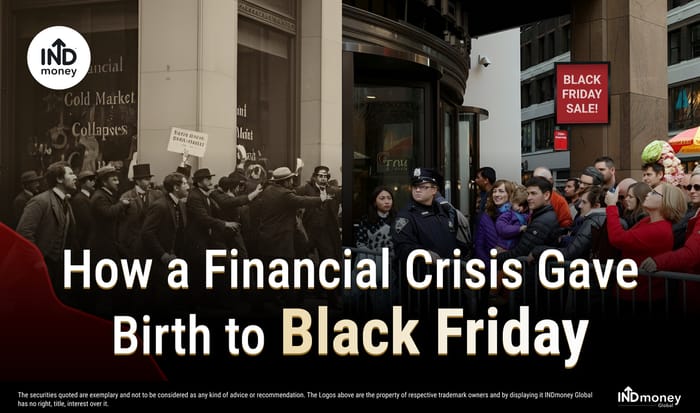
- The Original Black Friday: A Gold Market Scam
- How Black Friday Went From US Market Meltdown to Shopping Chaos
- How Financial Stress Keeps Shaping Black Friday
- Black Friday Goes Global and Lands in India
- Black Friday: The Panic to Growth Rebrand Success
When you hear “Black Friday” today, you think of app notifications, Black Friday deals and carts full of “wishlisted” gadgets. It actually started with something far more brutal: a full-blown financial crisis triggered by a failed attempt to game the gold market in 1869. Understanding that journey, from Wall Street panic to global discount festival, is not just trivia. It tells you how markets, crises and consumer behavior keep re-inventing each other.
The Original Black Friday: A Gold Market Scam
The phrase “Black Friday” first appeared in the context of a financial meltdown on 24 September 1869 in the United States. Financiers Jay Gould and James Fisk tried to corner the American gold market by using political connections to keep government gold off the market, hoping to drive prices up and book massive profits.
For a while, it worked. Gold prices spiked, stock markets became unstable and real-economy players like farmers were caught in the crossfire. When the US Treasury finally stepped in and sold gold, the bubble burst in a single day.
Gold prices crashed, stock prices fell about 20% within a week, brokerage firms went bankrupt and commodity prices, including wheat and corn, collapsed, hurting half of the American workforce that depended on farming.
That day of chaos was labelled “Black Friday”. It was not about shopping. It was about leverage, speculation and policy reaction in a young, fragile financial system.
How Black Friday Went From US Market Meltdown to Shopping Chaos
The term “Black Friday” then went quiet for decades. It resurfaced in a very different context in the 1950s and 1960s in Philadelphia. Local police officers started calling the day after Thanksgiving “Black Friday” because of the traffic jams, crowds and shoplifting that hit the city when suburban shoppers and football fans poured in ahead of the Army–Navy game.
Retailers did not like a name that associated their biggest sales day with disorder. So, by the 1980s, marketing teams began to reframe Black Friday as the point when stores moved “from red to black” on their profit and loss accounts. Historians point out that this “red to black” story is more of a clever backfill than the actual origin, but the rebrand worked. Black Friday became a positive symbol of profitability and consumer demand instead of a police headache or a market crash.
How Financial Stress Keeps Shaping Black Friday
The link between crisis and consumption did not end in 1869. Modern Black Friday has repeatedly been shaped by financial stress.
After the 2008 global financial crisis, American consumers became more price sensitive, and discount-led events like Black Friday and Cyber Monday turned into key levers to unlock hesitant spending. Retailers extended deals, pushed heavier promotions and leaned on e-commerce to reach cautious households. That model has only deepened in an era of high inflation and uneven wage growth.
Major global names such as Amazon, Walmart, Target, Costco, Best Buy, Apple, Nike, Adidas, IKEA and Sephora are now widely recognised for Black Friday offers across electronics, appliances, beauty, lifestyle and fashion. Even today, forecasts show that holiday sales growth is moderating while consumers still chase value.
According to Salesforce, Black Friday is expected to drive $78 billion in online global sales and $18 billion in the US alone. In parallel, cost-of-living pressures keep pushing shoppers towards these concentrated sale events, where they can bunch big-ticket purchases into one discount window rather than spread them across the year.
Black Friday Goes Global and Lands in India
What started as a US-specific calendar anomaly is now a global retail template. In India, brands have actively imported the Black Friday Sale playbook and blended it with their own campaigns.
E-commerce and consumer brands run deep-discount events around the same time, with offers ranging from 50% to 85% off select categories, and have reported strong jumps in gross merchandise value and new customer acquisition during these windows.
Black Friday: The Panic to Growth Rebrand Success
If you zoom out, Black Friday is a live case study of how markets recycle shock. A term born in a gold-market panic in 1869 now describes one of the biggest demand-creation events in the global retail calendar.
So, the next time you see a Black Friday banner, you are not just looking at a sale. You are looking at the long shadow of a financial crisis that started with a gold bet on Wall Street and ended up shaping how the world shops in November.
Disclaimer:
The content is meant for education and general information purposes only. Investments in the securities market are subject to market risks, read all the related documents carefully before investing. Past performance is not indicative of future returns. The securities quoted are exemplary and are not a recommendation. This in no way is to be construed as financial advice or a recommendation to invest in any specific stock or financial instrument. Readers are encouraged to verify the exact numbers and financial data from official sources such as company filings, earnings reports, and financial news platforms and to conduct their own research, and consult with a registered financial advisor before making any investment decisions. All disputes in relation to the content would not have access to an exchange investor redressal forum or arbitration mechanism. INDmoney Global (IFSC) Private Limited, Registered office address: Office No. 507, 5th Floor, Pragya II, Block 15-C1, Zone-1, Road No. 11, Processing Area, GIFT SEZ, GIFT City, Gandhinagar – 382355.